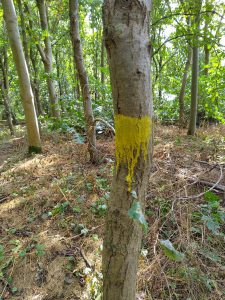Around this time of year visitors will start to see that certain trees have splashes of yellow paint on their trunks. This isn’t vandalism but a necessary step in the management of the wood.
The trees carefully selected for marking are those which will be available for felling or coppicing during the coming winter’s work parties. These are usually sycamore or Norway maple trees: species not native to the wood and ones which will take over if allowed to. Elm may be selected as coppicing encourages shoots to grow and at a certain size these trees almost always succumb to Dutch Elm Disease. Finally, in certain spots, ash trees are thinned under the guidance of our Notts Wildlife Trust advisor.
Unlike the larger trees felled by the Council and those which fall naturally during gales, there trees we mark are usually destined for use.
We constantly need lengths of trunk to replace rotted and displaced path edging, which forms the important function of encouraging visitors to stick to the official footpaths, thus enhancing the biodiversity of the off-path areas. Smaller branches and brash are used to create “dead hedging”, mostly around the perimeter of the wood to reinforce the fence and hedging – thereby limiting access to the official entrances and, again, enhancing biodiversity.
The Friends (and the Council) are very aware of the risk of ash dieback and how this may change the wood. This is an important factor influencing policy and management decisions.



